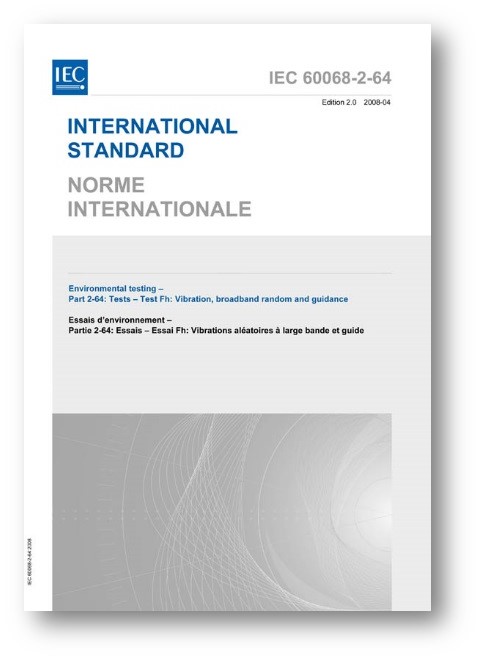International standards
IEC 60068-2-64:1993 Environmental testing – Part 2: Test methods – Test Fh: Vibration, broad-band random (digital control) and guidance
Overall improvement and quality increase of goods and services are integral components of the progress. Compliance and mutual interchangeability of the devices provided by various manufacturers contribute to the market development depending on individual tasks and resources.
However, this interchangeability is made possible by a variety of organizations, which collectively form World Stardards Cooperation – WSC.
Major goals of this world-wide cooperation are as follows:
- unification of quality of products, manufactured in different countries;
- interchangeability of complex products elements;
- assistance to the international trade development;
- contribution to the mutual exchange with scientific and technical documentation for the purpose of scientific and technical progress acceleration.
Thus, international standards can be described as important tools of global trade and financial development. These standards provide approved, stable, and universally acknowledged basis for propagation and implementation of technologies. Besides, these standards increase the role of the global market and form the major factor of world trade and development.
International standardization society includes three organizations:
International Organization for Standardization (ISO)
International Electrotechnical Commission (IEC)
International Telecommunication Union (ITU)

Today we shall consider the international standard, which has been developed by IEC Technical Committee 104 (Environmental conditions, classification and methods of test) and was published in 1993.
IEC 60068-2-64:1993 Environmental testing – Part 2: Test methods – Test Fh: Vibration, broad-band random (digital control) and guidance.

The present standard prescribes the criteria of specimen resistance to the dynamic loads without inacceptible deterioration of its functions and/ or its structural integrity, as it is exposed to certain tests for random vibration impact. The broadband random vibration can be used for evaluation of the accumulated strain, that is attributed to mechanical defects and deterioration of the initial characteristics. This data and the relevant technical specifications are used for evaluation of specimen’s acceptance criteria.
This standard is also applicable to the specimen, that can be exposed to vibrational impact of random (stochastic) type in the course of transportation or operation, e.g., on planes, space and terrain vehicles. Its primary function is the testing of unpackaged specimen, while it can also be applied for packaged specimen (in the case if the package is an integral part of the specimen).
Methods and procedures of the present standard are based on digital control of random vibration impact.
What is the reason for us to consider this very standard? Everything is quite simple. We are the manufacturers of digital shaker controllers, hence, we are particularly interested in compliance of our products with modern trends in the sphere of tests performance.
In the RF, the present standard has been introduced in 1999, i.e., after 6 years since its publication by the Technical Committee 183 “Vibration and shock”:
IEC 60068-2-64-93:Environmental dynamic testing for machines, instruments and other articles. Exposure to broad-band random vibration (digital control).
The second revision of this standard has been introduced in 2002 as the MOD to the primary document (IEC 60068-2-64:1993).
In 2008 there was issued an updated enhanced version of the IEC 60068-2-64:2008.
In spite of this fact, GOST 30630.1.9-2002 is still used as the basis for testing of the specimen resistance to mechanical impact.
Inconsistency of these standards is obvious from the first pages of the documents, for instance, in the number of terms and definitions.
New revision of IEC 60068-2-64:2008 contains recommendations concerning sequence of test impacts for each of the mutually transverse axes:
- analysis of the primary frequency response to sinusoidal or random vibration impact of low level;
- random vibration level in mechanical or test load mode;
- final analysis of the frequency response for the purpose of comparing the new data with primary results, and detection of the possible mechanical damage based on the change of dynamic properties.
The document contains recommendations concerning frequency characteristics of the measurement system (including converter, signal processing module, data acquisition and processing system), since it is an important factor in terms of measurement precision.
The list of information, which has to be included into into the specifications for tests performance, has also been increased, besides, the standard specifies the information, that has to included into the test report.
In addition to that (for informational purposes), the annex of the standard contains typical test profiles, corresponding to different types of transportation.
Thus, GOST 30630.1.9-2002 does not contain complete information to be used for tests performance in compliance with international standards. Besides, the structural organization of the standard is arranged in such a way, so that it would be compatible with other standards, while some of the clauses are substituted by links to other standards, which makes it quite difficult to use the document in question.
Shaker controllers by ZETLAB allow to conduct all types of tests implying external mechanical impact in compliance with all relevant international standards. The description software and hardware system ZETLAB VCS is available on our web-site.
Below you can see a general overview of main functions and advatages of the vibration testing control systems by ZETLAB:
• Compliance with state-of-the-art world trends in the sphere of testing performance (in particular, testing with high kurtosis level).
• Measurement of the specimen characteristics in the course of standard and periodical testing performance.
